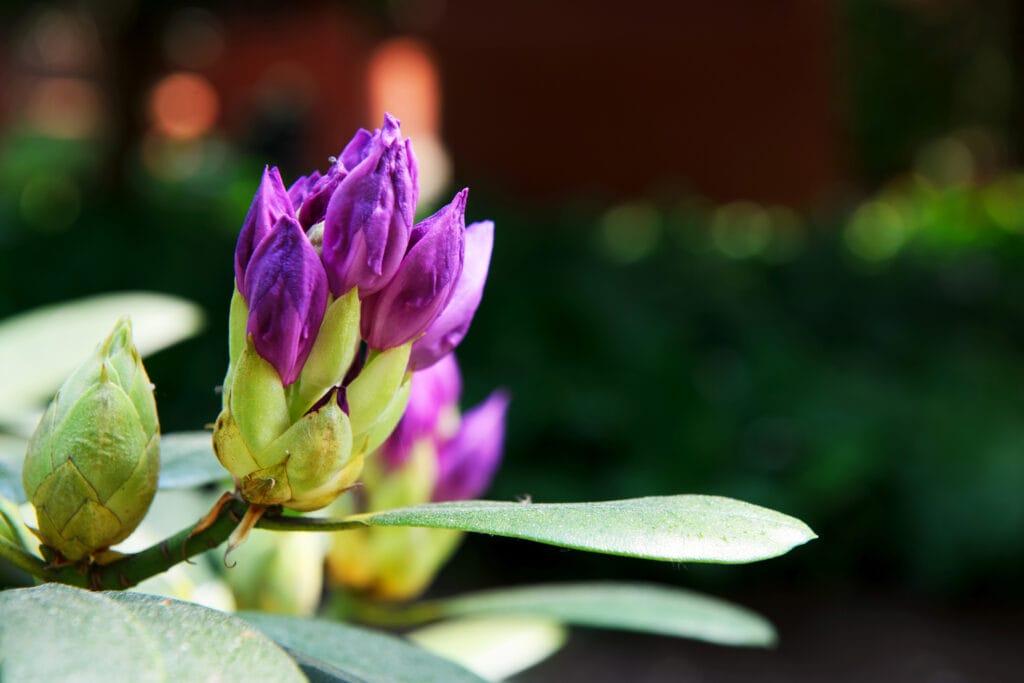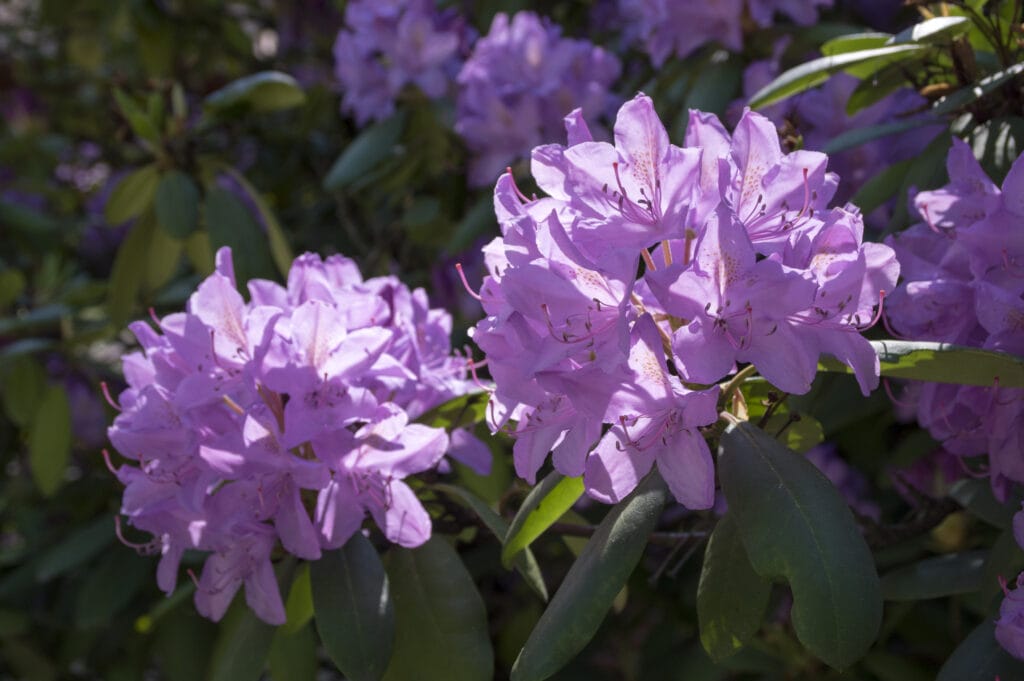Rhododendron is a large genus of flowering plants in the family Ericaceae. These acid-loving shrubs have been a mainstay of UK woodland planting schemes since their introduction. Purple rhododendron, or Rhododendron ponticum, is found all over the UK, particularly in woodland areas. Whilst, yellow rhododendron, or yellow azalea, has colonised many wet heaths and bogs. Unlike its relative, Rhododendron ponticum, yellow azalea does not usually form dominant stands. However, both are amongst the three invasive plants of the genus able to create problems that lead to the need for rhododendron removal.

Emerging purple flower and bud of rhododendron ponticum istock.com/gilotyna
Which rhododendrons are invasive?
Rhododendron is an established, ‘non-native plant’ within the UK. Plant species of this types are threatening a variety of British ecosystems. The following three Rhododendron are listed under Schedule 9 of the Wildlife & Countryside Act 1981:
- Yellow azalea or yellow rhododendron (Rhododendron luteum),
- Rhododendron ponticum,
- Rhododendron ponticum x maximum.
Those growing these rhododendron species on their land, have a responsibility to prevent it from spreading into the wild.
Where do rhododendrons come from?
Rhododendrons were brought to the UK from the Mediterranean, specifically the Caucasus region, and from parts of Asia. Rhododendron ponticum is perhaps the most ubiquitous of the three invasive rhododendron species. The purple or mauve flowers and den-like, evergreen growth habit is a common sight in UK woodlands and heathland. Purple rhododendrons of this type, are frequently used in ornamental gardens. Their beautiful flowers and the evergreen foliage adds an attractive splash of colour over the winter.
Yellow azalea, yellow rhododendron (Rhododendron luteum), is also an invasive species. This species is deciduous and tends to form a smaller shrub than R. ponticum. However, it is also capable of spreading rapidly and becoming a nuisance to native flora and fauna.
The third of the invasive rhododendron, is a hybrid. The plant is a cross between R. ponticum and a large American species Rhododendron maximum, a white flowered, evergreen species native to the Appalachias.

Rhododendron luteum (yellow azalea) in flower istock.com/Imashev
Considerations when dealing with invasive rhododendrons
The purpose of Section 14 of the Wildlife and Countryside Act 1981 is to ‘prevent the release into the wild of certain plants and animals which may cause ecological, environmental, or socio-economic harm.’ Three Rhododendron species are listed under Schedule 9, which lists already established UK non-native species. These species pose a continued conservation threat to native biodiversity and habitats, and as such, should be regulated as per Section 14 of the Act.
It is vital that the three invasive Rhododendron species be prevented from spreading further into our natural environments. Therefore, careful removal and responsible disposal are important when handling this common garden ornamental. All three produce large quantities of viable seed. They also spread through the action of layering, where the branches establish additional root systems when they come into contact with the soil. In effect, this ‘walks’ the plant into new areas of available light and nutrients.
How to identify Rhododendron ponticum
Rhododendron ponticum is a large, bushy shrub that can reach heights of 6-8m when mature. It has dark green, thick and glossy leaves that are elliptical and lanceolate with smooth edges. The flowers are very showy and appear in dense clusters at the ends of branches. Rhododendron ponticum has mauve flowers, leading to its common name Purple Rhododendron. The blooms have a funnel shaped corolla with five lobes and can be up to 5cm across.
An evergreen shrub, the species produces branching, woody stems, and spreads as wide as it grows high. The woody stems eventually form tree-like trunks that curve and loop within cover of the glossy leaves. The centre of the shrub is usually easily accessible and feels den-like, especially when found in woodlands. Pink rhododendrons aren’t always Rhododendron ponticum, as there are thousands of plants in this genus. And, many of which have pink or pinky purple flowers.

Rhododendron ponticum (purple rhododendron) in flower istock.com/Vagnerova
Why is rhododendron a problem?
Rhododendron problems are frequently an issue for those managing woodland or heathland sites. In many of these locations its vigorous growth has swamped native flora, outcompeting other plants for light, nutrients and space. Here, it often sprawls unchecked through the understory of many woodlands in the UK.
Whilst they will grow almost anywhere, rhododendrons thrive in acid soil. And, certain species once established, create an inhospitable environment for their neighbours. This continues even after excavation. The leaf litter of R. ponticum is extensive and slow to breakdown. Having a large biomass layer, coupled with the shading of the plants canopy, makes it difficult for seedlings to get started. This then leads to bare patches surrounding the plants, where there might otherwise be diverse ecosystems. The slow decaying dropped leaves create nutrient lock up, which creates depleted soils in areas that would naturally be more fertile.
The problems continue when bees consume the nectar and return it to the hive. The honey that is produced contains chemicals that can cause significant stomach upset and cardiac distress if it is eaten by humans. The entire plant contains grayanotoxins which are a defence against insects. In addition, the plants also contain a wide range of phenols and diterpenes which dissuade grazing herbivores. Taken together, it means the UK the plant has no natural environmental controls that might slow its spread.
Are rhododendrons poisonous?
The poisons in rhododendron can be attributed to Grayanotoxins, a group of related neurotoxins. These toxins are exuded in high concentrations from young leaves, but also (to a lesser degree) other plant matter.
Great distress can be caused by eating the nectar rhododendrons produce, though it is not the only way people have been poisoned by the plant. Eating the leaves or flowers of the plants can also lead to toxicity. Even contact with the plant can cause skin irritation for some people. It is always recommended that gloves are worn when handling it.
All parts of the rhododendron plant are poisonous for dogs. Symptoms include gastrointestinal upset followed by weakness, paralysis, and abnormal heart rhythms (arrhythmia). It is advised that you seek veterinary attention if you think your pet has consumed rhododendron.
Do rhododendrons poison the soil?
Whilst it is commonly stated that rhododendron does ‘poison the soil’, there is some debate over this. What is clear is lasting impact rhododendron ponticum, in particular, can have to an area it was once present. Despite this, recent analysis would suggest that there is ‘no evidence of a chemical legacy’ from the plant. There is, however, an impact to understory plant communities and Mycorrhizal fungi after a prolonged period of suppression. The impact on some species can last decades.
Is it illegal to have rhododendrons?
It is not illegal to have invasive rhododendron species in your garden or woodland. However, it is illegal to allow them to spread into the wild. The Wildlife and Countryside Act 1981 is in place to protect our native habitats in the UK from invasive species such as R. ponticum, R. luteum and R. ponticum x maximum. Care must be taken when handling rhododendron prunings, roots or soil that may be contaminated with seeds. Rhododendron problems in the UK have led to legislation that dictates how and where plant matter can be safely disposed of – it can’t be put in your green or garden waste. It is wise to consult professionals when dealing with these invasive plants of this type.
How do you stop rhododendrons from spreading?
In the UK, efforts have been made to control and manage rhododendron due to its invasive status. Once established, the plant is costly to remove. In 2010 it was estimated that it was costing £8.6 million a year to control rhododendron across the UK. It is clearly better to prevent future invasions rather than deal with the costly consequences of complacency.
Methods used to try and manage the spread of the invasive Rhododendron species include cutting it back, herbicide application to stumps and foliage, or excavation. Rhododendron removal can be a big task, often requiring multiple approaches and ongoing observation to ensure complete eradication is achieved. Hand pulling seedlings is an option if the infestation is only just getting established. Or, if you are controlling its spread from an area where it is contained. However, complete removal is often encouraged so that the risk of its spread into the wild is minimised to zero.

Rhododendron luteum istock.com/Andrei Lavrinov
Mechanical Excavation
The most thorough method of control is complete extraction. This will require the aerial parts to be felled and the roots and seed-contaminated soil to be excavated. Grubbing out the roots of a well established, mature plant can be an arduous job without professional help, the right skills and tools.
Herbicidal Treatments
Stumps can be treated with herbicides once the top parts are cut down. However, cut stumps will still be prone to regrowth and untreated roots may produce suckers. Follow up treatments are likely to be required and continuing monitoring is essential. Foliar treatments are an option, however the herbicides used are not selective and could potentially damage other plants in the area.
If you require assistance with the the control or removal of invasive rhododendron, or any other Schedule 9 invasive plant, get in touch with our team. Call 0203 174 2187 or 01202 816134 to talk to one of our consultants today.
Lead page image | iStock.com/Lucy Ryan

